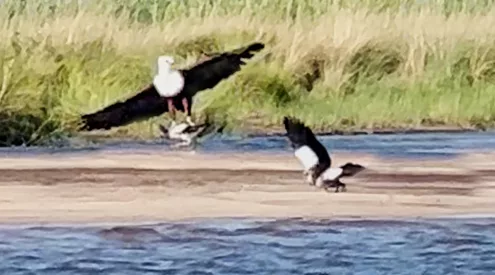Charlie, Nina, Thomas, Dinka and Zee lived with their parents in the tree tops of a Sudanese forest. They were blissfully unaware of the dangers around them and it was a good life, based on a solid family structure. Until the day the bushmeat traders hunted down their troop.
Their parents were killed, but because the five orphans were too small to become bushmeat they were carted off to a market where they would fetch good money as pets or entertainers.
Fortunately their story has a happy ending. The young chimps were rescued and now live at the Jane Goodall Institute Chimpanzee Eden, close to Nelspruit in Mpumalanga, with other rescued chimps such as Zac, who was found chained to a tree outside a nightclub in Luanda, Angola, and Charles, who used to entertain people in a circus in South Africa.
An ever-growing market for bushmeat is one of the biggest threats to chimps’ existence and some sources estimate if this trend continues, they’ll be extinct in the natural environment – mostly in the forests of east and central Africa – within 10 years. Altogether, Chimpanzee Eden has more than 30 of the primates in its care. One of the aims is to educate the general public about their closest animal relatives in an effort to save these charming apes from extinction.
Neuroanatomists have noted the circuitry of the chimp brain resembles that of a human brain more closely than any other species. They can learn to use symbols and understand aspects of human language, they walk upright when carrying things, use sophisticated gestures to communicate and they’re protective of their group members. Chimpanzees are also status conscious, manipulative and capable of deception. They have well-developed, almost military-like hunting strategies requiring co-operation, influence and rank. Although a human brain is three times bigger than that of a chimp, we can’t write them off as mere wild animals. Wolfgang Kohler, a psychologist who studied chimps in laboratories, published his Mentality of Apes in 1925, concluding that ‘chimps manifest intelligent behaviour; a type of behaviour which counts as specifically human’.
During her years of research, Jane Goodall made a significant discovery in 1960 when she noticed how chimpanzees make tools to acquire food. In Senegal, chimps sharpen sticks with their teeth to spear bushbabies out of their hiding places. Tool making is one of the things that set humans apart from the rest of the animal kingdom, so the discovery cast a whole new light on this relationship.
Despite this close connection with humans, there are fewer than 200 000 individuals left in the wild; our closest relatives have joined a myriad other species on the endangered list. Perhaps it’s time for us to recognise the challenges, opportunities and ultimate victory of saving a species so close to our own.
Sources:
- The Pocket Book of Animals by John Lloyd and John Mitchinson (Faber and Faber, 2009).
- In The Shadow of Man, revised edition, by Jane Goodall (Weidenfeld Paperbacks, 1988).
More about Jane Goodall and her work
To read more about Jane Goodall and her work, go to www.janegoodall.co.za.
Get up close and personal with chimps in South Africa at Chimpanzee Eden (www.chimpeden.com).
(Photograph courtesy of Morguefile.com)
















